
"In an age of virtual connectivity and increased reliance on the internet for daily functions, including by marginalized groups, can companies and technologists reframe their features or standards to support the most marginalized users' needs? Can the modes of resilience within digital spaces from some of the most marginalized groups be listened to, learned from, and centered when creating technology? Design From the Margins (DFM), a design process that centers the most impacted and marginalized users from ideation to production, pushes the notion that not only is this something that can and must be done, but also that it is highly beneficial for all users and companies."
"This report outlines how the DFM method can be used to build our most well-known and relied-upon technologies for decentered cases (often deemed "edge cases" which is atypical or less common use case for a product) from the beginning of the design process, rather than retrofitting them post-deployment to cater to communities with what are perceived to be extra needs."
"To that end, the theory presented within this research states that designing from the margins benefits all, and that what is created for the decentered cases will always be generalizable for the broader usership. This is a vital element of DFM. The established framework and design tailored for these cases can be finetuned and given to broader userbases, with the understanding that your tool, product, platform, feature is at its most robust if the metric of success is based around how it protects your most vulnerable and disenfranchised demographics."
Design From the Margins (DFM) centers the most impacted and marginalized users from ideation to production. Consumer interest conversations must be reframed beyond the largest use cases and United States and European Union centrism to prioritize decentered cases. Technologies should be built for decentered cases from the start rather than retrofitting post-deployment to meet perceived extra needs. Solutions designed for marginalized users will generalize to broader usership and strengthen overall product robustness. Success metrics should prioritize protection of vulnerable and disenfranchised demographics. Achieving this requires in-depth research, contextual nuance, and investment in design and development.
Read at The Belfer Center for Science and International Affairs
Unable to calculate read time
Collection
[
|
...
]